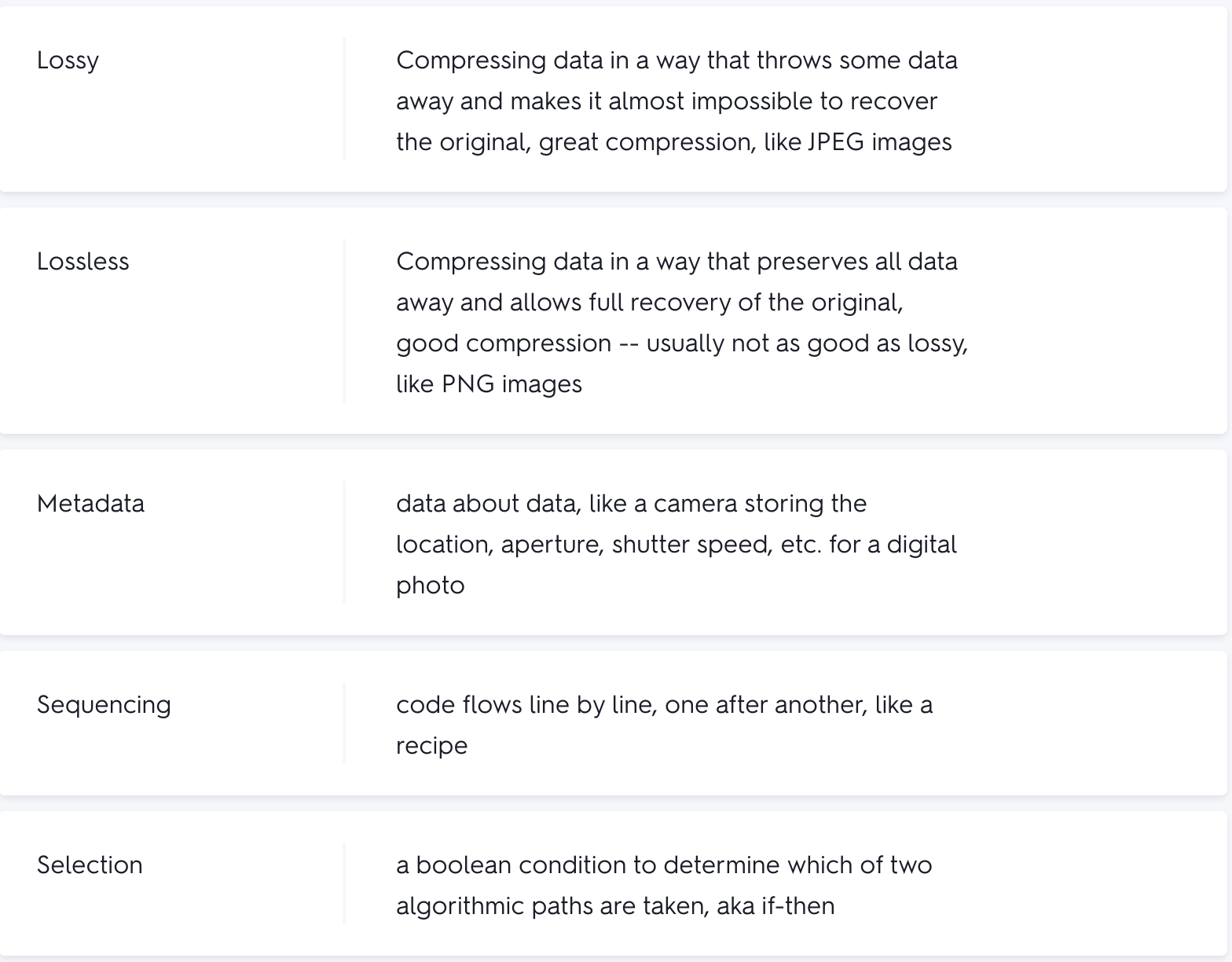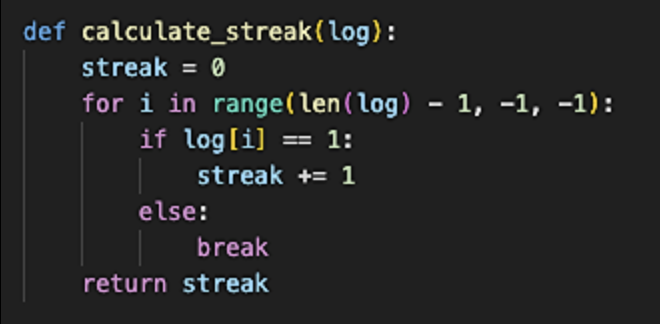Lessons and MCs
| Title | Description | Link |
|---|---|---|
| Heuristics and Undecidable Problems | Heuristics and Undecidable Problems - Teach Teach | View Post |
| Random Algorithms | Random Algorithm - Team Teach | View Post |
| Lists and Filtering | Lists and Filtering - Team Teach | View Post |
| Binary Search | Binary Search - Team Teach | View Post |
| Computing Bias | Computing Bias - Team Teach | View Post |
| Beneficial/Harmful Effects | Beneficial/Harmful - Team Teach | View Post |
| Crowdsourcing | Crowdsourcing - Team Teach | View Post |
| Legal and Ethical | Legal and Ethical - Team Teach | View Post |
| Safe Computing | Safe Computing - Team Teach | View Post |
| Group 4 Lesson (Tri 1) | Conditionals | View Post |
| Group 3 Lesson (Tri 1) | Looping | View Post |
| Group 2 Lesson (Tri 1) | —— | View Post |
| Group 1 Lesson (Tri 1) | —— | View Post |
| MCQ 2 | Collegeboard MCQ 2 | View Post |
| MCQ 3 | Spring Break MCQ | View Post |
| Big Idea 4/1 | Big Idea 4/1 | View Post |
Resources
College Board AP CSP Course & Exam Description (CED)
- https://apcentral.collegeboard.org/media/pdf/ap-computer-science-principles-course-and-exam-description.pdf
- https://apcentral.collegeboard.org/courses/ap-computer-science-principles/classroom-resources
CodeHS, repl.it, Khan Academy
- https://www.khanacademy.org/computing/ap-computer-science-principles
Albert.io practice problems
- https://www.albert.io/ap-computer-science-principles
- https://www.albert.io/blog/ap-computer-science-principles/
Quizlet / Anki decks for vocab
- https://quizlet.com/207034674/ap-computer-science-principles-exam-quizlet-flash-cards/

Full-length AP practice tests (past released)
- https://apcentral.collegeboard.org/courses/ap-computer-science-principles/exam/past-exam-questions
Topic Weaknesses
Topics I Struggled With
I got 0/1 on the following AP Computer Science Principles questions. These results show me exactly what topics I need to work on.
1. Algorithms and Programming
Questions I Missed:
- Error in
numOccurrencesprocedure - Counting perfect numbers
- Moving a robot to a goal
- Comparing Program A and B outputs
- Moving a game piece on a board
Why It Matters: These are core skills in the “Algorithms and Programming” unit. It’s about understanding how instructions and code run step by step.
What I’ll Do to Improve:
- Practice tracing code with pseudocode and flowcharts.
- Debug small programs on CodeHS or Replit.
- Review how loops, conditionals, and functions actually work.
- Make sure I understand how an algorithm runs from start to finish.
2. Internet and Cybersecurity
Questions I Missed:
- What certificate authorities do
- How information moves through the Internet
- Why deleted info isn’t always gone from the Internet
Why It Matters: This topic explains how devices connect and keep data safe. It also helps me understand real-world internet issues.
What I’ll Do to Improve:
- Watch videos from CrashCourse and Khan Academy on the Internet and security.
- Draw diagrams showing how data is sent using TCP/IP and HTTPS.
- Study how certificate authorities work and how public key encryption keeps data secure.
- Understand the idea of digital permanence—why deleting something online doesn’t always make it disappear.
3. Data and Binary
Questions I Missed:
- What color a binary triplet represents
- Which Boolean expression matches a truth table
Why It Matters: This part is about how computers represent info like numbers, colors, and logic using binary.
What I’ll Do to Improve:
- Practice converting between binary and decimal.
- Learn how RGB values work in binary to make colors.
- Review how to read and write truth tables and match them with Boolean expressions.
4. Theoretical Computer Science
Questions I Missed:
- What a “reasonable time” algorithm is
- The idea of unsolvable problems
Why It Matters: This topic is about the limits of computers—what they can and can’t do—and how efficiently they do it.
What I’ll Do to Improve:
- Learn about time complexity and Big-O Notation basics.
- Study examples of problems that are unsolvable, like the Halting Problem.
- Review the idea that some problems can’t be solved no matter how good the algorithm is.
Time Management Check
I spent about 13 minutes total on these questions and still got them wrong. That probably means:
- I rushed or didn’t fully understand what the question was asking.
- I need to slow down and read more carefully.
How I’ll Fix This:
- Practice reading each question slowly and making sure I know what it’s asking before I answer.
- Mix timed and untimed practice so I can improve both speed and accuracy.
PPR/CPT Proof of Activity

Example PPR Submission (one part)

Big Ideas
💡 Big Idea 1: Creative Development (CRD)
Key Concepts:
- The process of developing programs through collaboration and iteration.
- Algorithms, program components, and user input/output.
Topics:
- CRD-1: Program design and development process
- CRD-2: Program functionality and input/output
- CRD-3: Collaboration in computing
Example Skills:
- Explain the purpose of a computing innovation.
- Describe the iterative nature of the development process.
- Collaborate effectively in a team environment.
📊 Big Idea 2: Data (DAT)
Key Concepts:
- How data is collected, analyzed, represented, and used in computing systems.
Topics:
- DAT-1: Digital data representation (binary, compression)
- DAT-2: Data abstraction and organization
- DAT-3: Use of data in solving problems
- DAT-4: Data storage, privacy, and security
Example Skills:
- Explain how data is represented in binary.
- Interpret visualizations and datasets.
- Identify data concerns in real-world scenarios.
🧮 Big Idea 3: Algorithms and Programming (AAP)
Key Concepts:
- Programming concepts: variables, conditionals, loops, functions.
- Algorithmic thinking, abstraction, and debugging.
Topics:
- AAP-1: Variables and assignment
- AAP-2: Data types and lists
- AAP-3: Logic, expressions, and conditionals
- AAP-4: Iteration
- AAP-5: Developing procedures
- AAP-6: Algorithm implementation and analysis
- AAP-7: Program testing and debugging
Example Skills:
- Trace through code to predict output.
- Write and use functions with parameters.
- Identify and fix logic errors in code.
🌐 Big Idea 4: Computer Systems and Networks (CSN)
Key Concepts:
- Internet infrastructure, protocols, and communication.
- Impact of systems and networks on innovation and security.
Topics:
- CSN-1: Computer systems (hardware/software interaction)
- CSN-2: Internet structure and protocols (IP, DNS, TCP)
- CSN-3: Fault tolerance, redundancy, scalability
Example Skills:
- Explain how data is transmitted over the internet.
- Describe how the Internet’s layered architecture works.
- Analyze how packet switching and redundancy support reliability.
🔍 Big Idea 5: Impact of Computing (IOC)
Key Concepts:
- The social, legal, and ethical impact of computing technologies.
Topics:
- IOC-1: Computing innovations and impacts on society
- IOC-2: Legal and ethical concerns (bias, copyright, access)
Example Skills:
- Explain positive and negative impacts of computing.
- Evaluate the equity and accessibility of computing innovations.
- Identify potential bias in data and algorithms.
🔐 Big Idea 6: Cybersecurity (CYB)
Key Concepts:
- Common threats to digital systems and ways to protect against them.
Topics:
- CYB-1: Cybersecurity basics
- CYB-2: Encryption and authentication
- CYB-3: Risk mitigation strategies
Example Skills:
- Describe the role of firewalls, antivirus software, and other tools.
- Explain the principles behind encryption techniques.
- Identify personal and organizational strategies for cybersecurity.
Daily Study Plan
Week 1: Big Idea 1 – Creative Development
- Day 1: Skim the AP CSP Course & Exam Description (CED). Write down the 7 big ideas and your weakest areas.
- Day 2: Watch 2 AP Classroom videos on program design. Take 5 bullet notes.
- Day 3: Write pseudocode for a simple app idea (e.g., timer or calculator). Include input, output, and purpose.
- Day 4: Read through a classmate’s code or a simple GitHub repo. Comment 3 things they did well.
- Day 5: Do 10 multiple choice questions (MCQs) on program development (Albert.io or another resource).
- Day 6: Sketch a flowchart for a small program. Use arrows, conditions, loops, etc.
- Day 7: Write a paragraph: “How does the iterative design process apply to programming?”
Week 2: Big Idea 2 – Data + Big Idea 6 – Cybersecurity
- Day 8: Watch a CrashCourse video on data and take 5 notes.
- Day 9: Make a table comparing lossless vs lossy compression. Add 2 real-world examples.
- Day 10: Do 10 MCQs on data formats, data compression, and storage.
- Day 11: Read about Caesar ciphers. Encode a message to a friend or classmate.
- Day 12: Watch an AP video on hashing vs encryption. Write 3 bullet takeaways.
- Day 13: Do 10 MCQs on cybersecurity. Identify your 2 weakest concepts.
- Day 14: Create a graphic or bulleted cheat sheet for common cyber threats and protections.
Week 3: Big Idea 3 – Algorithms & Programming
- Day 15: Practice writing 3 algorithms: one using sequence, one using selection, one using iteration.
- Day 16: Review Python/JavaScript loops. Code a countdown timer.
- Day 17: Watch 2 AP videos on functions and abstraction. Take 5 notes.
- Day 18: Do 10 MCQs on variables, loops, and procedures.
- Day 19: Read someone else’s code that uses a function. Rewrite it with a new purpose.
- Day 20: Design your own function. Write code and a short comment explaining abstraction.
- Day 21: Take a mini quiz (make your own or from a site). Score yourself.
Week 4: Big Idea 4 – Computer Systems & Networks
- Day 22: Draw a diagram of how DNS works (client → server → IP).
- Day 23: Watch 1 AP video on how the Internet works. Write 3 notes.
- Day 24: Do 10 MCQs on networks and the internet.
- Day 25: Explain in your own words: TCP vs UDP. Write 3–4 bullet points.
- Day 26: Create flashcards for: DNS, IP, TCP/IP, packets, protocols.
- Day 27: Diagram the path a YouTube request takes from your browser to a server.
Week 5: Big Ideas 5 & 7 + Practice Test Week
- Day 28: Read a short article about tech ethics. Write a 3–4 sentence reflection.
- Day 29: Do 10 MCQs on bias, ethics, and computing impact.
- Day 30: Review the Create Performance Task rubric. Score an example PT from College Board.
- Day 31: Do a 30-minute AP-style mini test (20 MCQs). Review each wrong answer.
- Day 32: Review everything: skim your notes, flashcards, and cheat sheets. Make a list of final review goals.